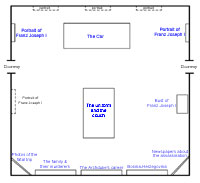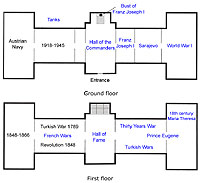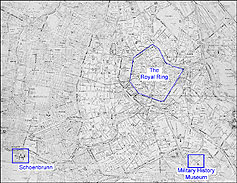The Sarajevo Room

|
The Military History Museum

|
The City of Vienna

|
NEW INTRODUCTION (as of June 29, 2014): This set of web pages was created about a decade ago for an NEH-funded project "World History Matters" which developed at George Mason University excellent resources to introduce students to the serious study of history. I was commissioned to create pages specifically for "unpacking evidence" provided by material objects. The historians at George Mason elected not to include these pages which follow here (created with the assistance of Lance Jenott, who did all the coding), although I felt it was important to provide guidance about how objects might be viewed and displayed by posterity. The point here is that one must always look at the context to understand how a museum may interpret objects (perhaps especially those which have some direct relevance to contemporary concerns). I have not changed the materials except for updating the links page. Unfortunately, my photos taken in the Military Historical Museum's room devoted to the Sarajevo assassination are substandard, given the dim lighting and the limitations of the slow film I was using. Since much higher quality images can be found on the Internet for some of that material, and my efforts to improve the digital versions of the photos have not been very successful, I have left those photos in place. They can at least serve the goal of the project in providing an annotated visual introduction to the exhibition. Readers should keep in mind that what I recorded about the exhibits more than a decade ago may have changed by now, although my sense from the view of the room provided on the current web pages of the Museum is that the basic presentation and even positioning of the objects is essentially the same.
The original set of web pages begins here:
In learning about how to use the evidence of objects for the writing of history, you have begun by asking several key questions:
The answers to those questions though may not take you very far in establishing the historical significance of an object. Many objects take on meanings that have little to do with their date, physical properties, or even some aspects of their individual histories. Where we now find an object and how it is presented to us may reveal a great deal about why the object is important and may also raise questions to us about possible different interpretations of its importance. Objects and their interpretation do provoke controversy, no matter how old the objects may be.
Many objects are now located in museum collections, organized in the exhibits by curators—experts who decide what to include and what to tell visitors to the museum about what is on display. It may well be that the descriptive information gives only a limited view of why an object is important. It is possible that the context in which it is displayed reveals more than the object itself for an understanding of the object's importance. This exercise invites you to explore objects in and beyond the context of their display in a museum.
Our example includes in fact three closely related objects—an automobile, a bloodstained uniform and a couch—which form the central part of a display in the Military History Museum (Heeres-geschichtliches Museum) in Vienna, Austria. We are calling that display the Sarajevo Room, since the objects in it connect with an event which took place in the city of Sarajevo in Bosnia-Herzegovina on June 28, 1914. One can argue that, taken by themselves, the objects would be of little consequence for the study of history. Yet they are connected with one of the momentous periods of world history in the 20th century, and they have a special significance for Austria. In examining the objects, after answering the basic questions for "unpacking" evidence, develop further questions:
Think of the process of learning about these objects and their context as one of exploring concentric circles. The objects are in the center and should form your starting point. The pages which follow are organized under three headings; for each a map or set of maps serves as an access point for obtaining further information. The headings are:
The Sarajevo Room

|
The Military History Museum

|
The City of Vienna

|
A list of recommended links will allow you to fill in gaps in your exploration and begin to draw even broader circles around those defined by these three headings. Some of the important questions about the history connected with the objects can be answered only if you go beyond the material contained here.
© 2003 Daniel C. Waugh and Lance Jenott